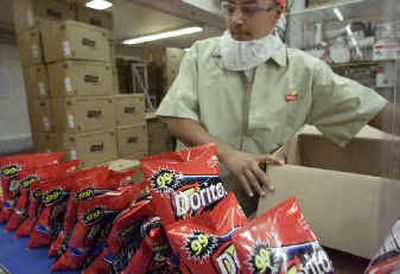Food industry nudged toward change

CHICAGO — Like many Americans at this time of year, the food industry has been talking a lot about healthy eating, improved nutrition and making better choices. Trans fats are out, whole grains are in and so are reminders about balanced lifestyles.
Whether or not it lasts longer than a New Year’s resolution, that commitment to healthier foods should soon be more evident in the marketplace.
Faced with childhood obesity concerns and changing dietary guidelines, packaged-foods makers and fast-food companies are responding with products and initiatives that will surface on store shelves and menus and in vending machines and TV ads.
Bob Goldin, an analyst at Chicago-based food consultancy Technomic Inc., senses “a real ground shift” starting to take place in the industry — even if consumers don’t sense it overnight.
“Slowly but surely, I think we are seeing some change,” he said. “We’re going to see some (more) product reformulation, changes in marketing practices and the introduction of foods that are healthier for you. But we’re very, very early in the game.”
So far, companies’ efforts to meet growing demands for healthier, more nutritious products have been a combination of “a lot of baby steps and lip service,” according to Goldin.
Federal officials took actions Wednesday that should make those steps bigger. They issued new dietary guidelines that set the stage for the revision of the familiar food pyramid in two months, advising Americans to eat more whole grains, fruits and vegetables and stick to fat-free or lowfat milk.
Food manufacturers tracked the year-long hearing process closely, taking notes and lobbying behind the scenes. They now are likely to come out with more whole-grain cereals and breads, more low-fat dairy products and perhaps changes in the ways french fries and chips are prepared, said Dr. Xavier Pi-Sunyer, a member of the dietary guidelines advisory committee.
“If they can say they’re following the guidelines, they’ll sell more products,” said Pi-Sunyer, director of obesity research at St. Luke’s-Roosevelt Hospital in New York.
A spate of announcements in the past week typified the shifts under way and testified to the pressure on companies to change.
Kraft Foods Inc., the nation’s largest food manufacturer, said it would curb advertising of Oreo cookies, regular Kool-Aid and other popular snacks to children under 12 to help encourage better eating habits. It also will begin labeling food and beverages that meet certain nutrition criteria with a flag touting the products’ benefits.
The vending machine trade association launched an anti-obesity campaign featuring a color-coded rating system with green (“Best choice”), yellow (“Choose occasionally”) and red (“Choose rarely”) stickers for items, based on nutrition content.
A symbol system is being used by PepsiCo Inc., which announced a major promotion for the “Smart Spots” now designating some of its Baked Lay’s, Tropicana and other products as healthier items. The company also has reduced the amount of sugar in Quaker cereals.
The Grain Foods Foundation trade group disclosed plans for a big ad campaign touting the nutritional value of grain-based products, capitalizing on the emphasis on bread and grains in the new USDA guidelines. That came three months after General Mills said it would convert Trix, Lucky Charms and all its other breakfast cereals to whole grain.
Also, Gorton Inc. announced it had removed trans fats from all 56 Gorton’s frozen seafood products, and Dannon Co. unveiled a new “heart-healthy” nonfat yogurt, Dannon’s Light ‘n’ Fit with Fiber.
What’s next — low-fat pizza?
Actually, that’s just been added to the menu at Pizza Hut. The Yum Brands Inc.-owned chain recently introduced the Fit ‘N Delicious pizza, containing 25 percent less fat than its regular version.
The healthier eating trend already has reshaped hamburger chains’ menus, although hardly displacing burgers and fries.
Salads introduced less than two years ago have become big sellers for McDonald’s Inc., which also is promoting healthier options such as Happy Meals with fruit along with low-fat milk and bottled water. Wendy’s International Inc. and Burger King Corp. have made similar menu tweaks, with positive results.
While it may be too soon to declare winners and losers from changes under way, analysts say many of the moves should pay off for companies.
“They’re beginning to realize that by making sure you’re on trend with the push for better, healthier foods, it can make a difference in your bottom line,” said Morningstar Inc. food analyst Mark Hugh Sam.
“The pendulum had swung toward too much marketing and toward the better-tasting aspects of food,” he said. “Now we’re seeing the pendulum swing back toward a balance between nutrition and taste.”
The biggest catalyst for change is public alarm about worsening obesity and nutrition problems among children, according to Goldin, who cites “a fair amount of fear” at companies — fear of regulation, litigation and consumer backlash.
Margo Wootan, director of nutrition policy at the Center for Science in the Public Interest, calls the recent moves “the first step on a long journey” toward addressing food companies’ products and marketing practices.
“Some of the steps that companies are taking are meaningful,” she said. “And others are staging PR events to try to deflect blame away from their products.”
Nick Hahn, a former Coca-Cola Co. marketing executive, said that simply eliminating “bad stuff” from their products isn’t a long-term solution for food companies.
“We need to move from a ‘no’ culture to a ‘yes’ culture,” said Hahn, managing director for the Vivaldi Partners consulting firm. “Instead of less bad stuff, we need to talk about more good stuff — more fresh products, organic products, high-mineral products.”